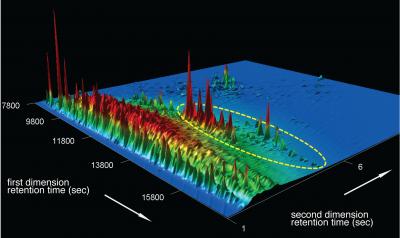Scientists identify Deepwater Horizon Oil on shore even years later, after most has degraded

Researchers used comprehensive two-dimensional gas chromatography (GCxGC) in their oil spill forensics to measure levels of degradation in biomarkers. THe biomarkers here are shown inside the dotted line. Credit: Christoph Aeppli, Bigelow Laboratory for Ocean Sciences
Years after the 2010 Deepwater Horizon Oil spill, oil continues to wash ashore as oil-soaked “sand patties,” persists in salt marshes abutting the Gulf of Mexico, and questions remain about how much oil has been deposited on the seafloor.
Scientists from Woods Hole Oceanographic Institution and Bigelow Laboratory for Ocean Sciences have developed a unique way to fingerprint oil, even after most of it has degraded, and to assess how it changes over time. Researchers refined methods typically used to identify the source of oil spills and adapted them for application on a longer time frame to successfully identify Macondo Well oil, years after the spill.
“We were looking at two questions: how could we identify the oil on shore, now four years after the spill, and how the oil from the spill was weathering over time,” explained Christoph Aeppli, Senior Research Scientist at Bigelow Laboratory for Ocean Sciences in East Boothbay, Maine, and lead author of the study reported in Environmental Science & Technology. Aeppli worked with his then-colleagues at Woods Hole Oceanographic Institution, and University of California, Santa Barbara on the investigation and report.
Researchers used comprehensive two-dimensional gas chromatography (GCxGC) in their oil spill forensics to measure levels of degradation in biomarkers. Biomarkers are molecular fossils. Each reservoir has specific amounts of different biomarkers, so oil biomarkers serve as identifiers much like human fingerprints.
Biomarkers are usually recalcitrant in reservoirs, but when exposed for a long time to the environment, some are altered due to natural processes. Oil consists of tens of thousands of compounds, and many of them can be degraded by bacteria or broken down by sunlight. This research was designed to determine the resiliency of specific biomarkers and to see how they held up when exposed to environmental conditions on shore.
“We found that some biomarkers—homohopanes and triaromoatic steroids (TAS), specifically – degraded within a few years following the Deepwater Horizon spill,” said Chris Reddy, a scientist at Woods Hole Oceanographic Institution and co-author of the paper. “These biomarkers are not as resilient as once thought and they may provide a future window into determining how much, and how quickly, these oil components may linger in the environment when exposed to air, sunlight, and the elements.”
Researchers sought to determine the specific source of the biomarkers degradation. Through analysis of oil-soaked “sand patties” collected along the Gulf shore over a 28-month period, they found that most biomarker compounds were recalcitrant and could be used to identify DWH oil. Some biomarkers, however, degraded. “This knowledge is helping us improve our oil spill forensics. It is providing a foundation for better, longer-term identification techniques that account for exposure of oil to wind, waves, sunlight, and microbial degradation over long times,” added Aeppli.
Aeppli, Reddy and colleague Dave Valentine from UC Santa Barbara will apply this new oil fingerprinting technique to process tens of thousands of samples collected shortly after the DWH spill.
The Woods Hole Oceanographic Institution is a private, non-profit organization on Cape Cod, Mass., dedicated to marine research, engineering, and higher education. Established in 1930 on a recommendation from the National Academy of Sciences, its primary mission is to understand the ocean and its interaction with the Earth as a whole, and to communicate a basic understanding of the ocean's role in the changing global environment. For more information, please visit http://www.whoi.edu.
Bigelow Laboratory for Ocean Sciences conducts research ranging from microbial oceanography to large-scale ocean processes that affect the global environment. Recognized as a leader in Maine's emerging innovation economy, the Laboratory's research, education, and technology transfer programs are spurring significant economic growth in the state.
Media Contact
All latest news from the category: Ecology, The Environment and Conservation
This complex theme deals primarily with interactions between organisms and the environmental factors that impact them, but to a greater extent between individual inanimate environmental factors.
innovations-report offers informative reports and articles on topics such as climate protection, landscape conservation, ecological systems, wildlife and nature parks and ecosystem efficiency and balance.
Newest articles

Long-sought structure of powerful anticancer natural product
…solved by integrated approach. A collaborative effort by the research groups of Professor Haruhiko Fuwa from Chuo University and Professor Masashi Tsuda from Kochi University has culminated in the structure…

Making a difference: Efficient water harvesting from air possible
Copolymer solution uses water-loving differential to induce desorption at lower temperatures. Harvesting water from the air and decreasing humidity are crucial to realizing a more comfortable life for humanity. Water-adsorption…

In major materials breakthrough
UVA team solves a nearly 200-year-old challenge in polymers. UVA researchers defy materials science rules with molecules that release stored length to decouple stiffness and stretchability. Researchers at the University…



